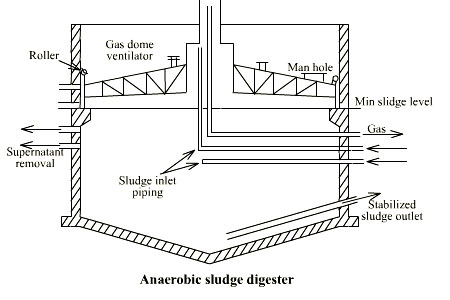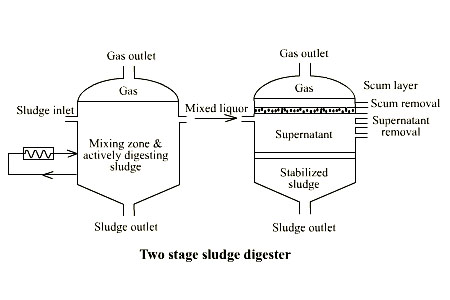Sludge digestion involves the treatment of highly concentrated organic wastes in the absence of oxygen by anaerobic bacteria.The anaerobic treatment of organic wastes resulting in the production of carbon dioxide and methane, involves two distinct stages. In the first stage, referred to as "acid fermentation", complex waste components, including fats, proteins, and polysaccharides are first hydrolyzed by a heterogeneous group of facultative and anaerobic bacteria. These bacteria then subject the products of hydrolysis to fermentations, b-oxidations, and other metabolic processes leading to the formation of simple organic compounds, mainly short-chain (volatile) acids and alcohols. However in the second stage, referred to as "methane fermentation", the end products of the first stage are converted to gases (mainly methane and carbon dioxide) by several different species of strictly anaerobic bacteria.
The bacteria responsible for acid fermentation are relatively tolerant to changes in pH and temperature and have a much higher rate of growth than the bacteria responsible for methane fermentation. If the pH drops below 6.0, methane formation essentially ceases, and more acid accumulates, thus bringing the digestion process to a standstill. As a result, methane fermentation is generally assumed to be the rate limiting step in anaerobic wastewater treatment. The methane bacteria are highly active in mesophilic (27-43°C) with digestion period of four weeks and thermophilic range (35-40°C) with digestion period of 15-18 days. But thermophilic range is not practised because of odour and operational difficulties.
Digestion Tanks or Digesters
A sludge digestion tank is a RCC or steel tank of cylindrical shape with hopper bottom and is covered with fixed or floating type of roofs.

Types of Anaerobic Digesters
The anaerobic digesters are of two types: standard rate and high rate. In the standard rate digestion process, the digester contents are usually unheated and unmixed. The digestion period may vary from 30 to 60 d. In a high rate digestion process, the digester contents are heated and completely mixed. The required detention period is 10 to 20 d.

Often a combination of standard and high rate digestion is achieved in two-stage digestion. The second stage digester mainly separates the digested solids from the supernatant liquor: although additional digestion and gas recovery may also be achieved.
